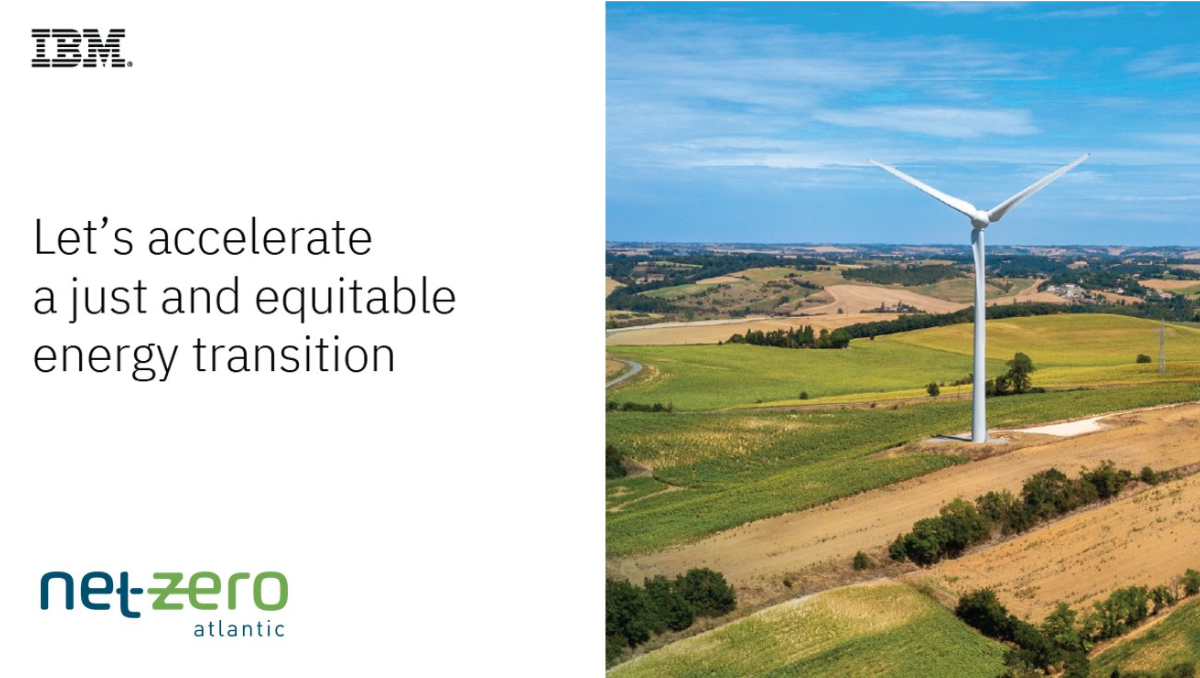As one of five organizations worldwide recently selected to join the clean energy cohort of the IBM Sustainability Accelerator, Net Zero Atlantic is benefiting from access to IBM technology, subject matter experts and pro bono services. The two organizations are currently working together with Indigenous communities in Nova Scotia to leverage advanced modeling capabilities and provide additional evidence and authority to support advocacy around clean energy policy and infrastructure buildout. The initiative will build upon Net Zero Atlantic’s existing Atlantic Canada Energy System (ACES) model. We asked Kathleen Mifflin, Net Zero Atlantic’s ACES model project manager and IBM Sustainability Accelerator liaison, to tell us more.
Why did you create an energy system model?
When we built the ACES energy system model, we made it open source. We thought that in doing so we would make it accessible to anybody who wanted to seek answers to the questions they had about the future of energy in our region. But once we started to get out there and show people the tool we built, we soon realized that it was still quite technically complex to use. We found we still had work to do to get to our end goal of democratizing access to energy system information. So, we've been seeking solutions to address that challenge.
What do you hope to achieve as part of the IBM Sustainability Accelerator?
We really want to take the model that we have built – which we think is a really awesome tool that can yield super helpful insights – and make it easy to use to produce results that make it possible for communities to understand ‘what does energy system change mean for us?’
Is there anything in particular you’re hoping IBM can help with?
One of the main things we're seeking to address through our engagement with IBM is to be able to address the time the model takes to solve. Because it is such a complex tool it can take anywhere from a couple of hours to a full day to solve the question that you ask it, and we think that this creates a challenge for user experience in terms of accessibility. If you can only ask one question a day, then you're really not getting very far with the tool. We're trying to figure out how to combat that through this process, and we're hopeful that with all of the resources IBM has, they'll be able to help us to fulfill the vision we have for the model.
Why have you decided to focus on Indigenous communities for this project?
We focused on Indigenous communities as our beneficiary because, looking at how energy development has historically progressed and where we need to go in the future, Indigenous communities really need to be taking the lead in determining where, when and how energy gets developed in and near their traditional lands.
What kinds of questions do you think the modeling tool will help Indigenous communities answer?
We're still really defining those questions with our Indigenous partners. It’s really important to have the end users at the table to make sure we're getting it right. But, from what we've heard and the main reason we were inspired to take the project in this direction in the first place, is one of the things Indigenous communities are grappling with is how to understand the cumulative impacts of energy development. So not just one project, but how do many projects all at once interact with each other and what impact do they have on communities. And, also, what does energy development look like in terms of jobs for communities and how can communities be better prepared to economically benefit from energy system change.
How do you see your team working together with IBM?
Our team at Net Zero Atlantic are the modelling experts and we created the model and know best how it can be used and the types of challenges our users are facing. Over the course of this project, IBM will be using their resources to build the technical solutions that will address the user experience challenges that we've encountered with model. They’re doing the legwork to build out the front end and the back end of our model to help achieve the vision we have for it.
How long will you be working together with IBM?
It's a two-year engagement, so it's quite significant. The first few months involve defining what the user needs are and then figuring out what our technical solution is going to look like. And then, within the first year beyond that initial period of engagement, we’ll be developing what is referred to as the minimum viable product.
What outcomes do you hope to see when this project is complete?
Our goal is that the average person who's working at an Indigenous organization that's advocating for energy development that Indigenous communities are going to benefit from will be able to engage directly with this tool. What we imagine is a graphical user interface that helps to guide users through the process of creating a scenario and analyzing its results. However, we're still at the early phases of the project, so these are all expectations at this point. This is an iterative process that we're going through with IBM, and right now we're still really defining what the problems are and then we're going to define what our technical road map is to address them. So, it will be interesting to see how the vision changes along the way. We also see this tool as being something that could have applicability outside of Atlantic Canada. So maybe that's what the future holds for this work as well – the possibility of extending the model’s reach beyond the boundaries of our region.
Find out more
Learn more about and access the ACES Model here, and find further details about Net Zero Atlantic’s induction into the clean energy cohort of the IBM Sustainability Accelerator here.

